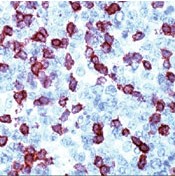CD3E (Cytopl. Dom.) Rabbit Monoclonal Antibody [Clone ID: SP7]
Specifications
| Product Data | |
| Clone Name | SP7 |
| Applications | IHC, WB |
| Recommended Dilution | Western blotting. Use Jurkat cells as positive control. Immunohistochemistry on Formalin-Fixed Paraffin Embedded Sections: Use a 1/100 dilution in an ABC method (30 minutes at room temperature). Formalin fixed paraffin embedded tissue sections require high temperature antigen unmasking with 10 mM citrate buffer, pH 6.0, prior to immunostaining. Recommended positive control: Tonsil. |
| Reactivities | Canine, Equine, Feline, Human |
| Host | Rabbit |
| Isotype | IgG |
| Clonality | Monoclonal |
| Immunogen | A synthetic 13-mer peptide corresponding to aa 156-168 of the epsilon chain of human CD3 protein. |
| Specificity | This antibody reacts with the intracytoplasmic portion of the CD3 antigen expressed by T cells. It stains human T cells in both the cortex and medulla of the thymus and in peripheral lymphoid tissues. This antibody is suitable for staining normal and neoplastic T cells. |
| Formulation | State: Supernatant State: Liquid Tissue Culture Supernatant containing Sodium Azide as preservative. |
| Storage | Store the antibody undiluted at 2-8°C for one month or (in aliquots) at -20°C for longer. Avoid repeated freezing and thawing. |
| Stability | Shelf life: one year from despatch. |
| Database Link | |
| Background | T cell activation through the antigen receptor (TCR) involves the cytoplasmic tails of the CD3 subunits: CD3 gamma, CD3 delta, CD3 epsilon and CD3 zeta. These CD3 subunits are structurally related members of the immunoglobulins super family encoded by closely linked genes on human chromosome 11. The CD3 components have long cytoplasmic tails that associate with cytoplasmic signal transduction molecules. This association is mediated at least in part by a double tyrosine based motif present in a single copy in the CD3 subunits. CD3 may play a role in TCR induced growth arrest, cell survival and proliferation. The CD3 antigen is present on 68-82% of normal peripheral blood lymphocytes, 65-85% of thymocytes and Purkinje cells in the cerebellum. It is never expressed on B or NK cells. Decreased percentages of T lymphocytes may be observed in some autoimmune diseases. |
| Synonyms | T3/Leu-4 |
| Reference Data | |
Documents
| Product Manuals |
| FAQs |
{0} Product Review(s)
0 Product Review(s)
Submit review
Be the first one to submit a review
Product Citations
*Delivery time may vary from web posted schedule. Occasional delays may occur due to unforeseen
complexities in the preparation of your product. International customers may expect an additional 1-2 weeks
in shipping.






























































































































































































































































 Germany
Germany
 Japan
Japan
 United Kingdom
United Kingdom
 China
China



